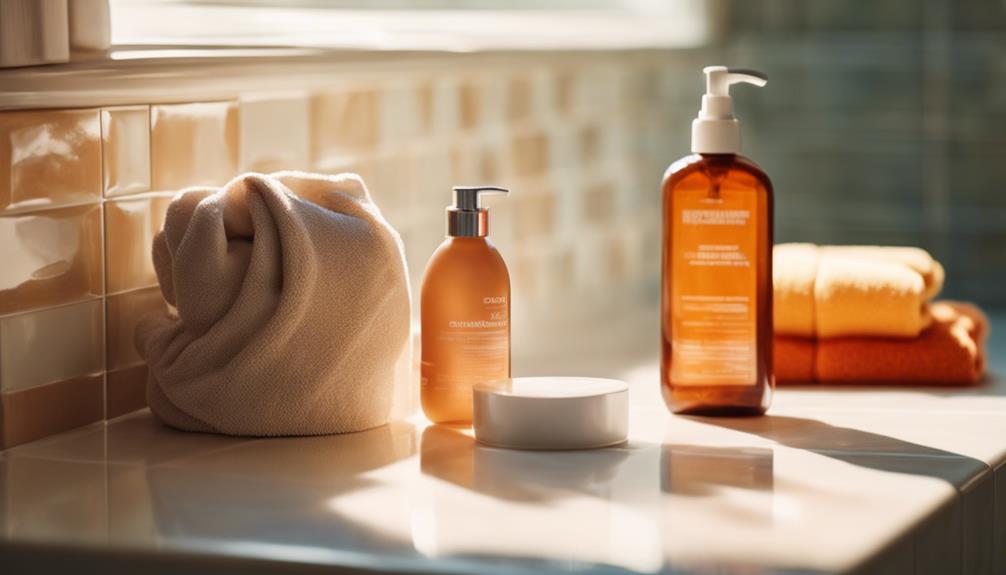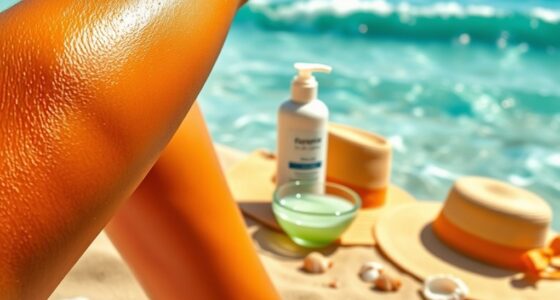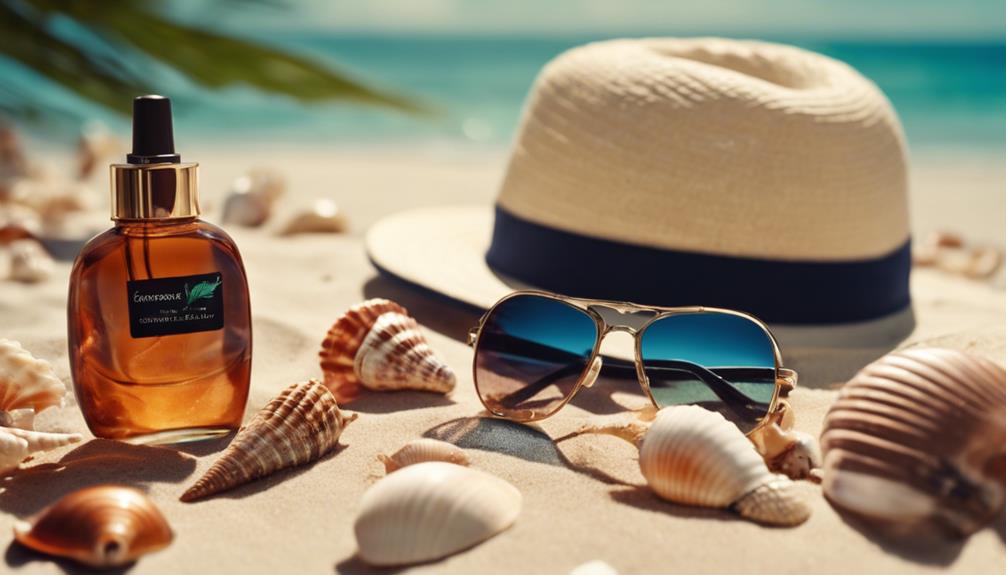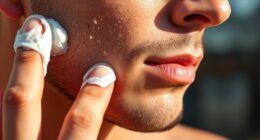To master your tanning bed sessions, start by knowing your skin type—this can save you from looking like a lobster! Prep your skin by exfoliating 24 hours beforehand, shaving a day or two prior, and hydrating with a good moisturizer. Begin with short sessions, around 5-10 minutes, and keep an eye out for any redness. Remember, consistency is key; go about twice a week. Finally, don't forget that post-tanning care keeps your glow alive—hydrate with lotion and drink plenty of water. There's a lot more to uncover about tanning, and you won't want to miss helping your skin shine! If you’re looking to take your tanning game to the next level, consider investing in tanning bed accessories like goggles and tanning lotions to enhance your experience. Additionally, improve your sideswitching skills to ensure an even tan all over your body. With these tips in mind, you’ll be well on your way to achieving a flawless, sun-kissed glow.
Key Takeaways
- Understand your skin type and choose appropriate tanning products to minimize burn risk and maximize results.
- Exfoliate 24 hours before tanning and shave 1-2 days prior for an even tan.
- Start with shorter tanning sessions to monitor skin reaction and adjust duration as needed.
- Hydrate your skin before and after tanning to maintain moisture and prolong your tan.
Understanding Skin Type
Understanding your skin type is essential for tailoring your tanning approach and minimizing the risk of burns.
If you've got fair skin, you might produce less melanin, which means you're more prone to burns—yikes!
Sensitive skin? You'll need to take extra precautions to avoid turning into a lobster. Each skin type reacts differently to UV exposure, so knowing yours can save you from painful consequences.
Don't hesitate to consult a dermatologist; they can provide personalized advice that's worth its weight in gold.
Remember, respecting your skin's unique sensitivity is key! You wouldn't want to ruin your tanning dreams with a nasty burn, right?
Pre-Tanning Preparation

Before you hit the tanning bed, make sure to prepare your skin properly for the best results. A little prep goes a long way! Here's a quick guide to help you get ready:
| What to Do | Why It's Important |
|---|---|
| Exfoliate 24 hours prior | Smooth skin helps an even tan. |
| Shave 1-2 days before | Removes hair for better tanning. |
| Remove makeup and perfume | Keeps your skin a clean canvas. |
Moisturizing and Aftercare

Moisturizing and aftercare are essential for maintaining an even, healthy tan and preventing skin damage after your tanning session.
After you step out of that cozy tanning bed, don't forget to slather on a hydrating lotion to lock in moisture. Your skin deserves a little TLC! Think of it like giving your skin a revitalizing drink after a workout.
And hey, drink plenty of water too; staying hydrated from the inside helps keep your skin glowing. If you've got specialized post-tanning lotions, now's the time to show them some love!
Remember, a well-moisturized canvas guarantees your tan lasts longer and looks fabulous.
Choosing Tanning Products

Choosing the right tanning products is essential for achieving an even and healthy tan that suits your skin type. It's like finding the perfect outfit—you want it to fit just right! Moisturizing lotions can really amp up your tanning results, while accelerators can speed things up for a deeper glow. Don't forget SPF; keeping your skin safe is key! Check out this handy table to help you choose:
| Skin Type | Recommended Product |
|---|---|
| Fair Skin | Moisturizing Tanning Lotion |
| Medium Skin | Tanning Accelerator |
| Olive Skin | Bronzing Lotion |
| Dark Skin | Deep Moisturizer |
| Sensitive Skin | SPF-Infused Tanning Lotion |
With the right products, you'll be on your way to a fabulous tan in no time!
Optimal Session Practices

Engaging in ideal tanning session practices is essential for achieving a beautiful and lasting glow while minimizing the risk of skin irritation.
Start with shorter sessions—maybe just 5 to 10 minutes—to see how your skin reacts. If you notice any redness, it's time to back off!
Knowing your skin type can help you find that sweet spot for session length, so pay attention. Consistency is key, too! Aim for twice a week, allowing a few days in between for your skin to recover.
This way, you'll build a lovely tan without looking like a lobster. Remember, tanning is like baking a cake; you don't want to rush it or you might end up with a burnt mess!
Enjoy your glow!
Timing and Environmental Factors

To maximize your tanning results, pay attention to the timing of your sessions and the environmental factors that can influence your skin's response to UV exposure. Tanning in the morning or early afternoon typically offers gentler UV rays, making it a smarter choice. You'll want to steer clear of peak UV hours to keep your skin safe.
Here's a quick guide to help you out:
| Time of Day | UV Intensity | Best Tanning Tips |
|---|---|---|
| Early Morning | Low | Great for fair skin |
| Late Morning | Moderate | Ideal for building a base tan |
| Early Afternoon | High | Short sessions recommended |
| Late Afternoon | Moderate | Good for touch-ups |
| Evening | Low | Not recommended for tanning |
Keep these tips in mind, and you'll be on your way to that golden glow!
Common Mistakes to Avoid

Many people make common mistakes when tanning that can lead to undesirable results or skin damage.
First, skipping exfoliation is a no-go; it leaves your skin uneven and can trap dead skin cells.
Don't forget to remove makeup and perfume, which can cause weird reactions with the tanning bed.
Also, avoid tanning over sunburns—your skin will scream at you!
It's essential to listen to your body; if you feel discomfort, it's time to stop.
Finally, remember to hydrate afterward; your skin deserves a drink too!
By steering clear of these slip-ups, you'll be well on your way to a fabulous, safe tan that'll have you glowing with confidence.
Frequently Asked Questions
How Often Should I Clean My Tanning Bed?
You should clean your tanning bed after every use to guarantee hygiene and prevent the spread of bacteria. Regular maintenance keeps the surface safe and enhances your tanning experience. Don't skip this essential step!
Can I Use Tanning Beds if I Have Tattoos?
Did you know that about 30% of people with tattoos experience fading from UV exposure? If you've got tattoos, you can still use tanning beds, but be sure to protect your ink with sunscreen or cover-up.
What Should I Wear During a Tanning Session?
During a tanning session, wear minimal clothing to avoid tan lines. Consider a swimsuit or specially designed tanning attire. Don't forget protective eyewear to shield your eyes from UV exposure and guarantee a comfortable experience.
Are Tanning Beds Safe for Pregnant Women?
When it comes to tanning beds and pregnancy, think of it as walking a tightrope. It's best to avoid them; the UV rays can pose risks. Always consult your doctor for safe skin practices during pregnancy.
How Do I Know if My Tanning Bed Is Effective?
To know if your tanning bed's effective, monitor your skin's color change after sessions. If you're not seeing results after a few visits, adjust your time, products, or consult a tanning professional for advice.
Conclusion
So, there you have it! With a sprinkle of preparation, a dash of diligence, and a heap of happiness, you're ready to shine like a sunbeam.
Remember, your tanning journey is all about balance—basking in the glow while keeping your skin safe.
Avoid those pesky pitfalls, and you'll be flaunting that fabulous, flawless tan in no time.
Get your gear ready, and let's light up the tanning world, one session at a time!









